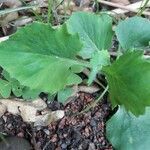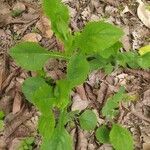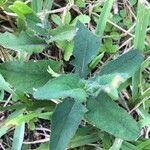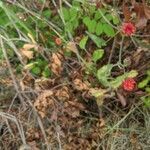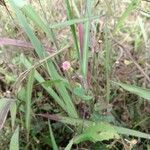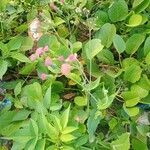Annuals to 0.5 m high, transiently densely coarse-hairy on new growth. Leaves to c. 8 cm long, with l:w ratio c. 2–4, undivided; base becoming truncate to auriculate upwards; margin dentate. Capitula solitary or few; mature peduncle to c. 80 mm long; involucre 7–12 mm long, 3–7 mm diam.; bracts c. 6–8, glabrous; stereome flat, with 3–5 resin ducts; receptacular pits not or slightly raised. Florets c. 30–numerous; corolla 7–11 mm long, exceeding involucre by 2–4 mm, c. 0.4 mm wide at base; limb c. 1/2 of total length, very narrowly campanulate, purple-red; style appendage purple. Achenes obloid, with 5 broad ±flat ribs, 4–5 mm long; ribs brown or stramineous, scattered short papillose hairs in grooves. Pappus 5–8 mm long.
Herbs, annual. Stems erect or ascending, 20-60(-100) cm tall, glabrous or sparsely pilose. Basal and lower stem leaves petiolate; blade ovate, ± dentate, strongly decurrent into petiole; median stem leaves oblong to oblong-lanceolate, base semiamplexicaul-hastate, margin shallowly to deeply dentate, apically acute; upper leaves ovate to lanceolate, dentate or entire, becoming bractiform upward. Capitula in lax compound corymbs. Involucres cylindric to suburceolate, ca. 15 × 5 mm; phyllaries ca. 10. Florets definitely exceeding involucre at anthesis; corolla dull red, with slender tube and cylindric limb; lobes 1-1.5 mm. Achenes ca. 5 mm, pubescent between ribs. Pappus white. 2n = 20.
Annuals, 20–100 cm, glabrous or sparsely arachnoid-villous proximally. Stems 1, often somewhat lax, simple or branched. Leaves ± equally distributed; sessile and auriculate to winged-petiolate and clasping; blades oblanceolate to pandurate, mostly 5–10 × 3–5 cm (distal smaller, bractlike), margins entire, toothed, or weakly lobed. Involucres campanulate to cylindric, 9–14 mm, relatively thick, lengths 1.5–2(–3) times diams. Phyllaries usually 8 or 13. Florets usually 50–60+, surpassing involucres by 2–4 mm; corollas pinkish, purplish, or reddish (not orange), lobes mostly 1–1.7 mm; style appendages ca. 0.2 mm. 2n = 20.
A herb. It grows each year from seed. It grows 50-80 cm tall. The leaves do not have stalks and they are oval and 7-13 cm long by 2-5 cm wide.
